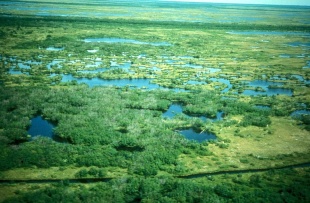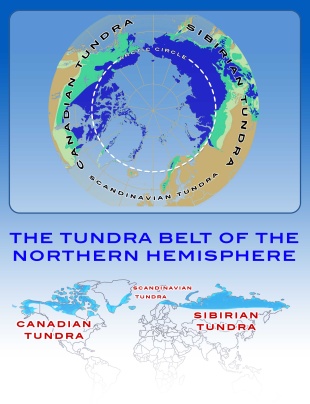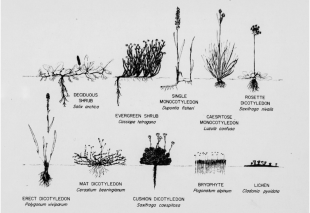TUNDRA
Tundra is the marshy, treeless plain that has low-growing vegetation and permanently frozen subsoil (permafrost). It is the northernmost of the five primary natural zones of Russia. Much of the Arctic is too cold for trees to grow. Much of the landscape is covered by a treeless, marshy plain, with a carpet of plants, called “tundra”, that spreads for as far as the eye can see in many places and is undisturbed except for streaks of snow, pools of water and rock piles. Most tundra areas lies within the Arctic Circle. Some lie in mountainous areas.
About 10 percent of Russia is tundra. The tundra is Russia's northernmost zone, stretching from the Finnish border in the west to the Bering Strait in the east, then running south along the Pacific coast to the northern Kamchatka Peninsula. The zone is known for its herds of wild reindeer, for so-called white nights (dusk at midnight, dawn shortly thereafter) in summer, and for days of total darkness in winter. The long, harsh winters and lack of sunshine allow only mosses, lichens, and dwarf willows and shrubs to sprout low above the barren permafrost. Although several powerful Siberian rivers traverse this zone as they flow northward to the Arctic Ocean, partial and intermittent thawing hamper drainage of the numerous lakes, ponds, and swamps of the tundra. Frost weathering is the most important physical process here, gradually shaping a landscape that was severely modified by glaciation in the last ice age. [Source: Library of Congress, July 1996 *]
Tundra regions sometimes receive less rain than a desert, but because there is hardly any evaporation and seepage is inhibited by the permafrost the land is spongy and soggy. And even though the growing season is very short, plant foods can become quite large by growing for many hours a day under the midnight sun.
Less than 1 percent of Russia's population lives in the tundra zone. The fishing and port industries of the northwestern Kola Peninsula and the huge oil and gas fields of northwestern Siberia are the largest employers in the tundra. With a population of 180,000, the industrial frontier city of Noril'sk is second in population to Murmansk among Russia's settlements above the Arctic Circle. *
Global warming has affected the tundra is is expected to affect it more in the future. By some estimates 15 percent of the Arctic tundra gas disappeared since the 1970s. Summer warming has reduced the number of days in which the tundra is hard enough to be driven on or drilled into.
Arctic Plants
Sedges, grasses, scrub willows, birch, juniper, cloudberries, cranberries, blueberries, lichens, mosses and fungi are the plants best adapted for growing in the tundra. These provide enough food to support large numbers of hares, mice, squirrels, voles, waterfowl, migratory birds—and with them, insects, including lots and lots of mosquitos. The main large animals living in the tundra are reindeer, musk oxen and bears. Trees that grow in the tundra are stunted dwarfs. The permafrost doesn’t allow trees to send down deep roots.
Common Arctic plants include stunted heather, willows, saxifrages, cotton grass and poppies. During the short Arctic summers there are ample supplies of sun, liquid warmth and sun warmth—which all plants need to survive. Dirt and minerals, which plants also need, are in short supply because rocks are not usually weathered into soil. The richest source of nutrients comes from animals and plants that die in the Arctic. Often large groups of plants can be found growing from the remains of a dead musk ox or fox.
Plants can not grow without light. Plants and animals that live in the Arctic are able to survive the dark, cold winter by reducing their life processes to a minimum and concentrating most of their activity in the short summer months, often 24 hours day. Because there so few seed- and pollen-carrying insects and small birds, many Arctic plants rely on the wind to disperse their pollens and seeds.
Unusual plants found in the Arctic including the Arctic poppy and willowherb, with flowers that bloom briefly in the short Arctic summer; the Arctic willow, a type of willow that crawls on the ground and rises no more tan a couple inches off the ground but may grow as large on the ground as a willow tree climb vertically. Seeds from lupin, an Arctic plant, can remain in the permafrost for as much as ten thousand years and be brought to life.
Lichens and Mosses
Lichens and mosses are among the most common forms of life in the tundra. Lichens are fungi-algae partnerships. They resemble single plants but they are components of fungi that can dissolve minerals that can be consumed by algae, with the algae producing starches and sugars that can be consumed by the fungi. Lichens often attach themselves to rocks that are slowly broken down with an acid to provide the algae with nutrients which in turn provides the fungi with nutrients. In this way lichen can thrive in harsh environment where few other living organisms can survive.
There are 20,000 different kinds of lichen. Some have brilliantly colored skins: red, yellow, blue, green and even black. Hanging mosses found in temperate rain forest are in fact lichens. Lichens grow up to 18,000 feet in the Himalayas and are one of the few living things that grow in the Antarctic and the islands in the Arctic. In the tundra they grow in massive ankle-deep carpets.
Mosses are filaments or small flowerless green plant which lacks true roots, growing in low carpets or rounded cushions in damp habitats and reproducing by means of spores released from stalked capsules. Mosses lack rigidity and often pack themselves together to form cushiony surfaces.
Mosses and liverworts (allies of mosses) practice two kinds of reproduction: sexual and asexual, in alternative generations. Green moss produces sex cells. Each large eggs remains attached to the stem at the top. The microscopic sperm are released into the water and wriggle their way to the egg to fertilize it. The egg then germinates while still attached to the parent plant to produce the next asexual generation: a thin stem with a hollow capsule at the top.
Mosses produces spores in small capsules at the top of their stem. When they are ready to releases a lid springs on the top to reveal a ring of teeth covering a mouth beneath it. If the weather is warm and dry the teeth dry out and curl backwards, opening the capsule and allowing the spores to blow away. If the weather is wet, the spores could become waterlogged and not carry far. To prevent this from happening the teeth reabsorb moisture and shut the capsule.
Reindeer moss is common in the taiga and tundra. Also known as reindeer lichen moss and caribou moss, it is not a moss. Rather it is a light-colored, fruticose lichen belonging to the Cladoniaceae family. It grows in both hot and cold climates in well-drained, open environments. Found primarily in areas of alpine tundra, it is extremely cold-hardy. As the names suggest, reindeer lichen is an important food for reindeer (caribou). Reindeer lichen, like many lichens, is slow growing (3–5 mm per year) and may take decades to return once overgrazed, burned, trampled, or otherwise consumed.
Tundra Wildlife and Animals
Tundra wildlife includes a variety of mammals, birds, insects, and fish adapted to the harsh, cold conditions and difficulty getting food in tree-less environment in the long, dark winter. Notable animals include Arctic foxes, caribou (reindeer), snowy owls, Arctic wolves, lemmings, musk ox, and a number of migratory birds. Among the adaptations that these animals have to Arctic condition are thick fur, downy feathers, white coats for camouflage, and the ability to hibernate or migrate to survive the cold and lack of food.
Arctic foxes are known for their thick, white fur, which provides excellent insulation and camouflage. Caribou (reindeer) are migratory herbivores that travel in herds and have specialized hooves for walking on snow and ice and digging up lichens in the snow, their primary winter food. Musk oxens are large, shaggy-haired herbivores that lived in Ice Age alongside woolly mammoths and caribou. Arctic wolves are a subspecies of gray wolf with a white coat, an adaption to snowy environments. Arctic hares are known for their large size and white winter coat. Lemmings are small rodents that are the primary food source for many tundra predators, whose fluctuating population sizes greatly impact other species.
Many species of swans, ducks, geese and and other migratory birds such as Arctic terns and snow buntings bred in the tundra during the summer and migrate south to warmer areas for the winter. Snowy owls are large, white owls that are a top predator in the tundra, relying on lemmings and other small rodents for food. Ptarmigan are a type of grouse that changes color with the seasons, from white in winter to brown in summer. Ptarmigan and snowy owls live in the tundra full time. Flies, moths, grasshoppers and other insects thrive in the tundra during the brief summer season. Many of them survive the winter by engaging in diapause — the insect form of hibernation. Mosquitoes, which lay eggs in still water, which is abundant in the tundra during the summer, can form huge swarms that annoy the hell out of human tundra visitors but provide food for birds and other animals.
RELATED ARTICLES:
MUSKOXEN: CHARACTERISTICS, HISTORY, BEHAVIOR AND REPRODUCTION factsanddetails.com
ARCTIC FOXES: CHARACTERISTICS, COLD, BEHAVIOR AND REPRODUCTION factsanddetails.com
ARCTIC GROUND SQUIRREL CHARACTERISTICS, BEHAVIOR, EXTRAORDINARY HIBERNATION factsanddetails.com
LEMMING BOOM-AND-BUST REPRODUCTION AND MYTHS ABOUT MASS SUICIDE factsanddetails.com
LEMMING SPECIES factsanddetails.com
NORWAY LEMMINGS: CHARACTERISTICS, BEHAVIOR AND REPRODUCTION factsanddetails.com
REINDEER AND CARIBOU: CHARACTERISTICS, FEEDING, CONSERVATION factsanddetails.com
REINDEER AND CARIBOU BEHAVIOR: MIGRATIONS, REPRODUCTION, PREDATORS factsanddetails.com
POLAR BEARS: CHARACTERISTICS, BEHAVIOR AND REPRODUCTION factsanddetails.com
POLAR BEARS, HUMANS. CONSERVATION: CLIMATE CHANGE, POLLUTION, TOURISM factsanddetails.com
POLAR BEARS ATTACKS: CIRCUMSTANCES AND BEHAVIOR OF THE BEARS AND HUMANS factsanddetails.com
POLAR BEARS ATTACKS REPORTED IN THE MEDIA factsanddetails.com
SNOWY OWLS: CHARACTERISTICS, BEHAVIOR AND REPRODUCTION factsanddetails.com
Permafrost
Permafrost is permanently frozen condition of soil except for surface soils that thaw when air temperatures rise above freezing. Thawing and refreezing cause instability of the soil, which greatly complicates the construction and maintenance of roads, railroads, and buildings. Permafrost covers roughly the northern one-third of the Russian Federation.
Much of land in the Arctic is frozen permanently into permafrost. Permafrost is essentially a bog frozen hard a brick. Sometimes the permafrost is several feet under the ground. Sometimes it lies under ice and snow at the surface. Melting permafrost creates bogs and pools of stagnant water and swamps filled with lichens, mosses and berries..
Nearly two thirds of Siberia is covered permafrost. Some of the permafrost created more than a million years ago and is more than 1,400 feet thick. In some places the permafrost is over 1,400 feet thick. According to the Guinness Book of Records, the deepest recorded permafrost (more than 4,500 feet deep) was recorded near the Viluy River, Siberia in February 1982.
In most places not covered by ice permafrost lies between two to six feet below the surface. In the summer when the earth above it melts the land becomes swampy because the permafrost prevents water from draining into the soil (in non-Arctic regions water percolates through the ground but in the Arctic it can't do that because the permafrost ground is frozen).
Permafrost also serves as a great preserver. Chocolate, bread, oatmeal, canned meat, preserved cabbage and food left by explorers in a permafrost cache in 1900 was found in 1976 and later eaten. An explorer who tried the food told the Times of London, “Although everybody was afraid to try it, the canned soup with meat proved to be very tasty.” This got the Russian government thinking. Some officials began making plans to set up a kind of strategic reserve for food in the permafrost. See Mammoths.
Melted permafrost turns flat ground into rippled, undulating ground and creates “drunken forest” made of trees tilting this way and that. Moss is critical to the permafrost. It insulates the soil, keeps it at subfreezing temperatures and helps it preserve ice throughout the summer. Permafrost is threatened by fires that burn off the moss and expose the permafrost to summer heat causing it to melt.
Living on Permafrost
Houses on the permafrost are anchored to pilings driven into the permafrost. Building are built on stilts bored 10 meters in the ground. Buildings on concrete foundations, which melts the permafrost, tilt ands sag. Under the pressure from wheels, railroad tracks and foundations, permafrost turns to mud. To keep them from sinking road beds have to be insulated and buildings erected in logs.
During the summer, the permafrost prevents drainage, turning the landscape into a swamp, filled with ponds, lakes and pools. When permafrost melts it creates a smell like rotting vegetation. In some part parts of Siberia anything deeper that a foot is solid ice year round and people simply use their basements as refrigerators. Some hunters have frozen rabbits piled up in their basement like firewood.
Great care has to be taken when placing buildings on permafrost. In some cases the non-permafrost ground is removed and layers of gravel and other materials are placed over the permafrost. In other cases special refrigeration equipment is installed to keep the ground frozen in the summer.
Permafrost is incredibly hard and almost impossible to dig by hand. Pick axes bounce right off it. It takes three days to dig a grave in the permafrost' and houses sometimes snap in two when the ice beneath them shifts a little. Miners use explosives, high-powered pressure water hoses that rip away permafrost layer at surprising speed but also at great expense. These hoses can eject 32,000 liters of water per minute from 100 meters away at pressures reaching 300 pounds per square inch.
Climate Change and Permafrost
The permafrost in a beat bog the size of France and Germany is melting in Siberia. The landscape is being transformed in a series of swamps and lakes, releasing billions of tons of methane trapped in the frozen peat In other places the permafrost line has moved 80 miles northward.
Melting permafrost results in drowned forests (as the permafrost melts the land sinks and is inundated with water), the creation of silk holes, buckled and cracked roads,, buildings with undermined foundations, unsafe bridges, and moving of runways.
Places that used to melt down to about 15 centimeters in the summer now melt down to 30 centimeters. Melting permafrost can expose nuclear, chemical and biological contaminants that had been buried and were thought to be safe from release in the frozen ground.
One of the biggest worries with global warming is the effect it will have on the vast methane deposits that are tied up in frozen bogs and permafrost. If the worlds’ largest frozen peat bogs in Siberia melt it will releases vast amounts of methane, which is 20 times more powerful from a global warming perspective than carbon dioxide..
To track the retreat of permafrost scientist examine plant-covered mounds called palsas that form naturally over ice in the soil of northern peat bogs. Their disappearance is sign that permafrost is melting.
See Separate Article: CLIMATE CHANGE, PERMAFROST, GREENLAND AND THE ARCTIC factsanddetails.com
Image Sources: Wikimedia Commons
Text Sources: New York Times, Washington Post, Los Angeles Times, Times of London, Lonely Planet Guides, Library of Congress, U.S. government, Compton’s Encyclopedia, The Guardian, National Geographic, Smithsonian magazine, The New Yorker, Time, Newsweek, Reuters, AP, AFP, Wall Street Journal, The Atlantic Monthly, The Economist, Foreign Policy, Wikipedia, BBC, CNN, and various books, websites and other publications.
Last updated June 2025



